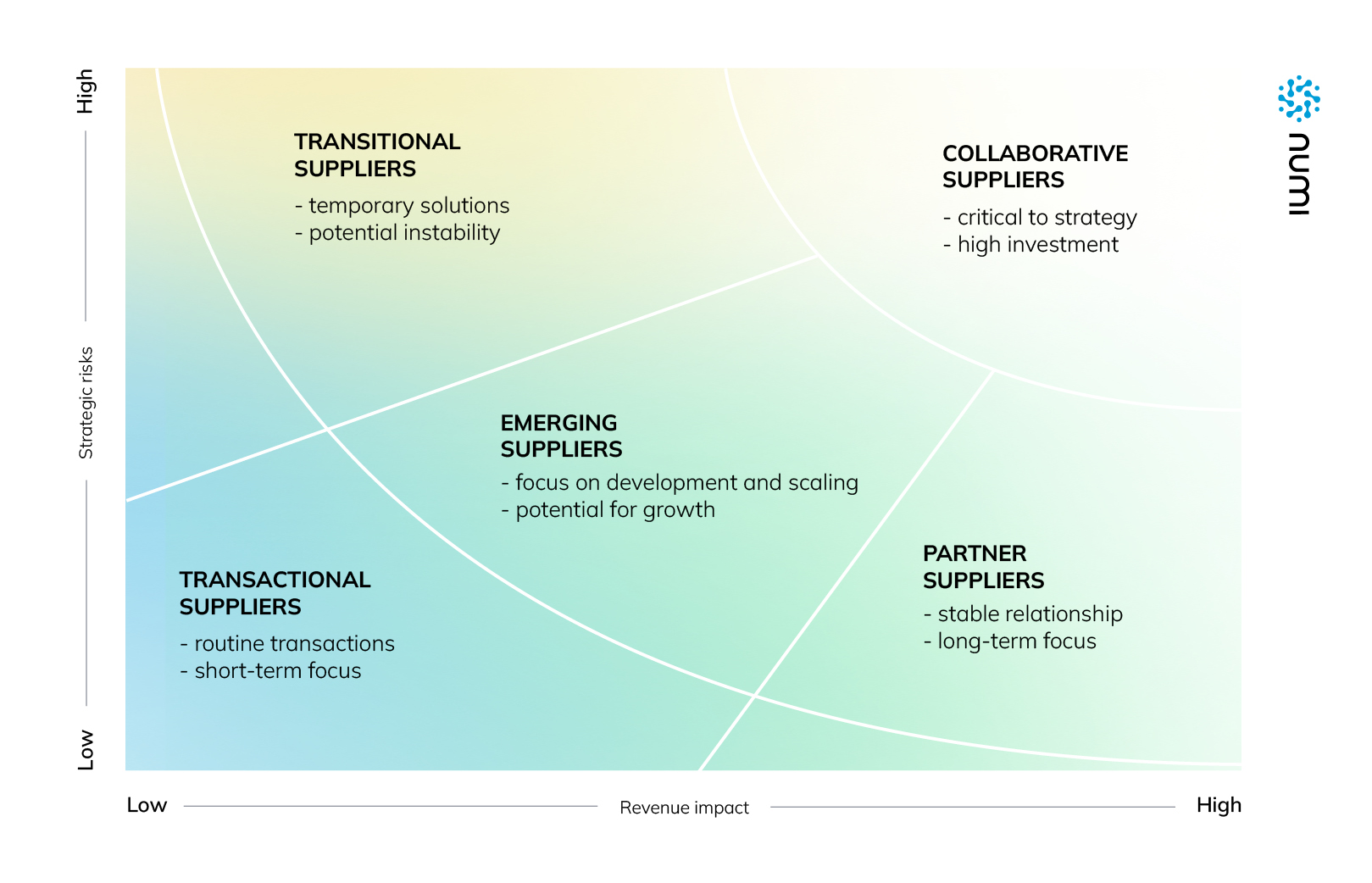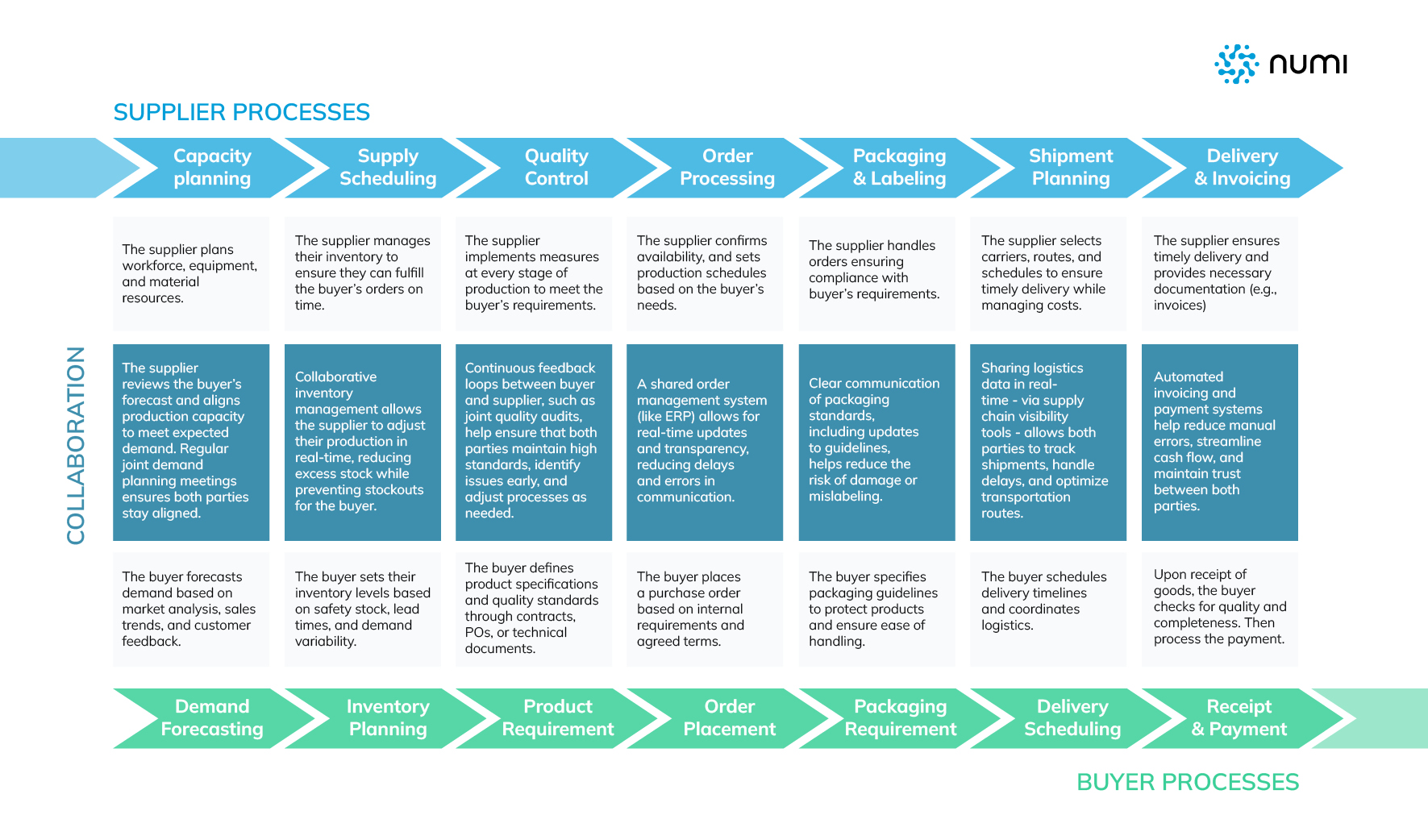
Supplier collaboration strategies for improved efficiency

Yulia Fedorova
26 Sep 2024
In today's fast-paced and ever-evolving global marketplace, supplier collaboration has become crucial for managing increasingly complex and interconnected supply chains. Companies are no longer operating in isolation; instead, they are part of vast networks of suppliers, manufacturers, and distributors spanning multiple regions and industries. This complexity, while enabling global reach and flexibility, introduces new challenges such as supply chain disruptions, fluctuating demand, and unpredictable market conditions. Supplier collaboration is a key strategy that goes beyond transactional relationships, enabling businesses to work closely with their suppliers to improve efficiency, drive innovation, and mitigate risks.
Unlike traditional supplier relationships, which often focus solely on price and delivery, collaborative supplier partnerships emphasize shared goals, transparent communication, and joint problem-solving. This approach allows companies to align with their suppliers on everything from production schedules and capacity planning to quality control and innovation.
The benefits of effective supplier collaboration are vast: improved product quality, reduced lead times, enhanced responsiveness to market changes, and the ability to innovate together with suppliers. By engaging suppliers in deeper, more integrated partnerships, companies can create value for both parties while building more sustainable, flexible supply chains.
Segmentation: Laying the foundation for effective collaboration
Before diving into specific collaboration types, it's essential to understand that collaboration strategies should be tailored to different suppliers. Segmentation helps companies categorize suppliers based on several key factors, ensuring they collaborate appropriately depending on the supplier’s role in the supply chain.

Key segmentation factors
Strategic significance
Definition: This factor evaluates how critical a supplier is to a company's core operations. Suppliers who provide key materials or services essential to the company's main product or service fall into this category.
Implications: Suppliers with high strategic significance often require more integrated and collaborative relationships. They may be involved in long-term planning and strategic discussions to ensure that their offerings align with the company’s objectives. For instance, a company’s primary technology provider or a critical raw materials supplier would be considered strategically significant. These suppliers might have joint development initiatives or closely coordinated production schedules.
Revenue impact
Definition: This assesses how much a supplier’s contribution impacts the company’s revenue. It looks at the direct financial contribution of the supplier’s goods or services to the company's overall income.
Implications: Suppliers who significantly affect revenue need to be closely aligned with the company’s long-term goals. These suppliers might be given priority in terms of relationship management and negotiation, as their performance and reliability can directly impact the company's financial health. For example, a supplier who provides a component that is crucial for a high-margin product would be closely monitored to ensure that their performance supports revenue targets.
Lead time
Definition: Lead time refers to the amount of time it takes for a supplier to deliver goods or services after an order is placed. Longer lead times can complicate inventory management and production schedules.
Implications: Suppliers with long lead times require more frequent and precise communication. Companies need to manage these relationships carefully to prevent delays and production issues. This might involve implementing advanced planning systems, establishing buffer inventories, or developing contingency plans. For instance, if a supplier has a 12-week lead time, the company might need to plan orders well in advance and maintain regular check-ins to ensure on-time delivery.
Relationship
Definition: This considers the historical interactions between the company and the supplier, including trust, reliability, and the overall quality of past engagements.
Implications: A strong, reliable relationship can lead to more dynamic and flexible interactions. Suppliers with a proven track record of reliability and trustworthiness are often given more strategic roles and may benefit from more collaborative practices, such as sharing of sensitive information or joint problem-solving efforts. For example, a supplier with a history of high-quality delivery and good communication might be involved in collaborative innovation projects or receive preferential terms.
Types of supplier collaboration
To optimize supply chain performance, businesses engage in different forms of collaboration with their suppliers. Here are five critical types of supplier collaboration:
Capacity collaboration
Capacity collaboration ensures that both the buyer and the supplier align their production capacities to meet demand efficiently. This type of collaboration involves sharing production schedules, resource availability, and capacity limitations between the two parties. By doing so, companies can avoid bottlenecks, plan for production peaks, and ensure that suppliers can meet fluctuating demand.
- Prevents production delays and shortages.
- Allows better planning during high-demand periods.
- Helps suppliers prepare for future demand, reducing the risk of overcommitting or underutilizing resources.
Inventory collaboration
Inventory collaboration involves the joint management of stock levels between buyers and suppliers. This collaboration allows for more accurate forecasting and stock replenishment, ensuring that companies have the right amount of inventory at the right time. It helps in reducing excess stock, avoiding stockouts, and managing lead times more effectively.
- Optimizes inventory levels and reduces carrying costs.
- Improves supply chain visibility, enabling faster response to market changes.
- Reduces the risk of stockouts and excess/obsolete inventory.
Order collaboration
Order collaboration focuses on synchronizing purchase orders between the buyer and supplier to ensure that the supplier can meet the buyer's requirements in terms of quantity and delivery time. By aligning order processes, both parties can avoid errors, improve order accuracy, and ensure timely fulfillment.
- Ensures order accuracy and reduces discrepancies.
- Minimizes lead times and improves on-time delivery.
- Aligns production and ordering processes, leading to more efficient operations.
Quality collaboration
In quality collaboration, buyers and suppliers work together to uphold consistent quality standards throughout the production process. This involves setting clear quality benchmarks, performing joint inspections, and engaging in continuous improvement efforts to ensure that products meet the required specifications.
- Reduces product defects and rework, improving customer satisfaction.
- Ensures early detection of quality issues, minimizing disruptions in the supply chain.
- Strengthens relationships by fostering shared responsibility for product quality.

Innovation collaboration
Innovation collaboration is more strategic and focuses on co-developing new products, processes, or solutions with suppliers. It involves jointly working on research and development efforts, new product introductions, or even sustainable practices. This type of collaboration allows both the buyer and supplier to drive innovation that benefits both parties and keeps them competitive in the market.
- Encourages the development of new products and solutions.
- Helps both parties stay ahead of market trends and customer demands.
Benefits and barriers of multi-tier collaboration
By engaging in different types of supplier collaboration, companies can realize significant benefits across their supply chain, including:
- Enhanced responsiveness: Collaborating with suppliers on capacity, orders, and forecasts allows companies to react more quickly to demand fluctuations and supply chain disruptions.
- Cost reductions: Effective inventory and sourcing collaboration can reduce excess stock, carrying costs, and expedite fees, resulting in lower overall costs.
- Improved product quality: Quality collaboration ensures that issues are detected early, reducing defects and improving overall product reliability.
- Risk management: By collaborating on forecasts and capacities, companies can identify potential risks earlier in the supply chain and develop mitigation strategies.
- Innovation and sustainability: Collaborating with suppliers on innovation initiatives can lead to the development of sustainable products and processes that benefit both companies and the environment.
Despite the benefits of multi-tier collaboration, many companies face challenges when implementing these strategies. Common barriers include:
- Lack of trust and transparency: Companies may hesitate to share critical data with suppliers due to concerns over data security and confidentiality.
- Disparate systems: Disconnected tools and platforms make it difficult to collaborate seamlessly with suppliers.
- Cultural and organizational resistance: Both internal teams and suppliers may resist changes in collaboration processes, especially if they require new technology or approaches.
To address these issues and unlock the full potential of supplier collaboration, companies need more than just strategies - they require robust tools that facilitate seamless integration and communication across the supply chain. Advanced platforms like numi Supplier Collaboration offer comprehensive solutions designed to overcome these barriers and enhance collaborative efforts.
numi Supplier Collaboration is specifically crafted to bridge the gaps that often arise in traditional supply chain management. By providing real-time data sharing, intuitive order management features, and collaborative workspaces, numi addresses the core challenges of transparency, system integration, and process alignment.
Enhancing collaboration with numi
numi Supplier Collaboration offers a comprehensive suite of features that align perfectly with the collaborative strategies discussed earlier. By integrating various types of collaboration—capacity, inventory, order, quality, and innovation—into a single platform, numi enables organizations to optimize their supply chain operations effectively.
Forecast collaboration
numi provides advanced forecasting tools that enable real-time sharing of demand projections and production plans with suppliers. This feature helps ensure that suppliers are well-prepared to meet future demand and adjust their production accordingly.
Capacity collaboration
With numi’s capacity management features, buyer and supplier can seamlessly update and monitor production schedules and capacity allocations. This prevents bottlenecks and ensures that supply can meet fluctuating demand peaks effectively.
Inventory collaboration
The inventory management functionality within numi enables joint management of stock levels through real-time data sharing. This helps optimize inventory, avoiding both excess stock and stockouts.
Order collaboration
numi provides a comprehensive supplier portal designed to enhance collaboration and transparency between buyers and suppliers. The portal offers real-time access to order data allowing both parties to monitor the status of orders at every stage. This visibility is crucial for aligning production schedules and managing inventory effectively.

Order dashboard and status tracking
Order dashboard and status tracking feature enhances supply chain visibility through customizable graphs and dashboard. Orders are divided into three main categories—delivered, open, and planned—which can be viewed using different units of measurement, such as order quantity, order lines, order weight, or order backlog. Users can also select the time unit for tracking—monthly, weekly, or daily—to gain detailed insights into their order statuses.
Additionally, dashboard features a chart that illustrates the distribution of orders across various stages of the timeline from new order to delivery. This chart displays the number of order lines at each stage, including MOS confirmation requested, MOS confirmed, order confirmed, and in-transit. This functionality allows both suppliers and buyers to effectively monitor the progress of their orders, align production schedules, manage inventory levels, and reduce discrepancies for improved accuracy in order fulfillment.
Order workbench
The Order Workbench feature is central to numi's order management system. It enables both suppliers and buyers to view, accept, and manage order changes and suggestions. This real-time visibility ensures that modifications are communicated promptly, facilitating quicker resolution of issues and enhancing coordination between parties.

To further support effective order management, the portal includes a detailed timeline for each order, capturing key statuses such as:
- Change requested by supplier/buyer: Indicates when either party requests a modification to the order, such as adjusting quantities or changing the dispatch date. This triggers a review process to evaluate the feasibility of the changes and communicate any impact on delivery schedules or costs.
- Order confirmed: Marks the official acceptance of the order by both parties, transitioning it from placement to fulfillment. This status ensures that all terms are clear and agreed upon.
- MOS confirmation requested: Signifies a request to confirm the mode of shipment (MOS), such as air freight or sea freight. This step ensures the chosen shipping method meets the delivery requirements and is appropriate for the order’s size and urgency.
- MOS confirmed: Confirms that the mode of shipment has been finalized and accepted. This confirmation is essential for planning logistics, scheduling transport, and estimating delivery times.
- In transit: Indicates that the order has left the supplier’s facility and is en route to the buyer.
- Delivered: Marks the successful arrival of the order at its final destination. This status completes the fulfillment process and prompts any necessary follow-up actions, such as finalizing payment and reviewing the order for any discrepancies.
Both supplier and buyer can see the exact day and time when changes or new statuses are recorded, enhancing transparency and tracking accuracy.
Order actions
The portal also supports various actions to manage orders effectively:
- Accept: Confirm receipt and approval of an order or its modifications, allowing it to proceed to the next stage.
- Adjust quantity: Modify the number of items in the order based on inventory levels or changing requirements.
- Adjust planned dispatch date: Change the scheduled dispatch date if there are delays or other factors affecting the timeline.
- Request mode of shipment: Specify or request a shipping method, such as expedited or standard shipping.
- Review mode of shipment: Verify the chosen shipping method to ensure it meets the order’s requirements and cost considerations.
- Set in-transit: Update the status to indicate that the order is currently being transported.
- Add invoice ID: Attach the invoice identification number to facilitate tracking payments and managing financial records.
numi's order synchronization capabilities ensure real-time alignment of purchase orders and delivery schedules, minimizing discrepancies and streamlining the fulfillment process. This collaborative platform serves as a hub for discussion, feedback, and process optimization between buyers and suppliers.
Ready to elevate your supplier collaboration and optimize your supply chain operations? Experience the power of numi Supplier Collaboration firsthand by scheduling a personalized demo. Our team will walk you through the tool’s features, demonstrate its capabilities, and show you how it can be tailored to meet your specific needs.